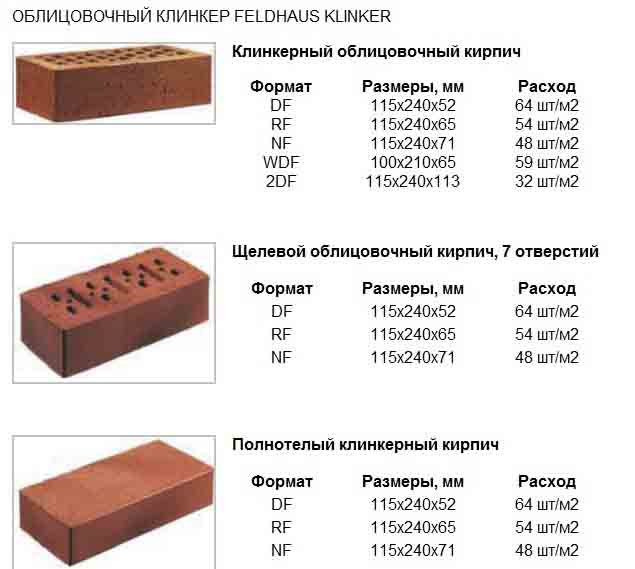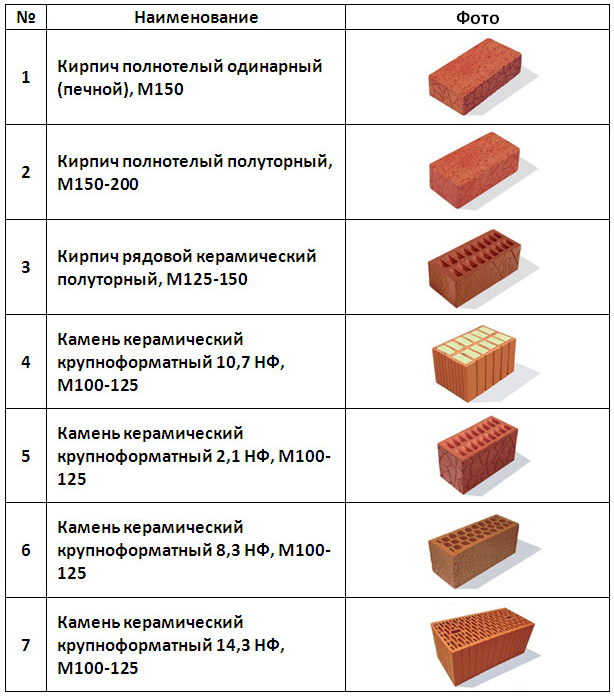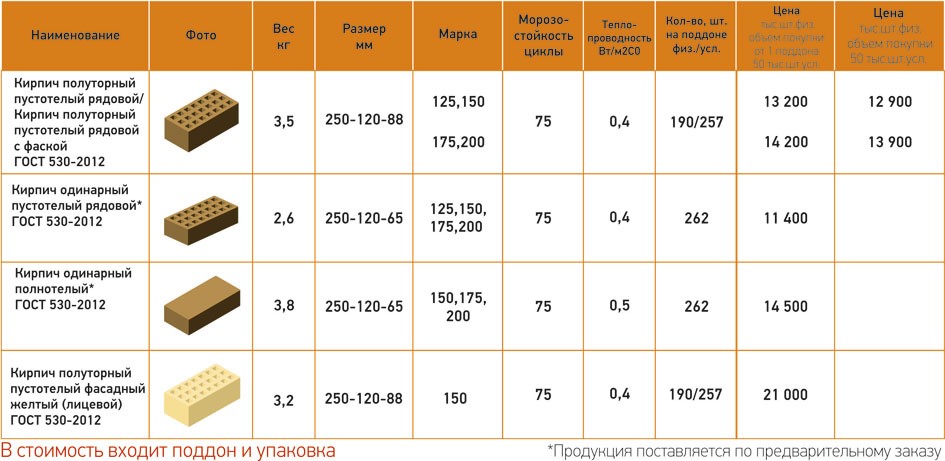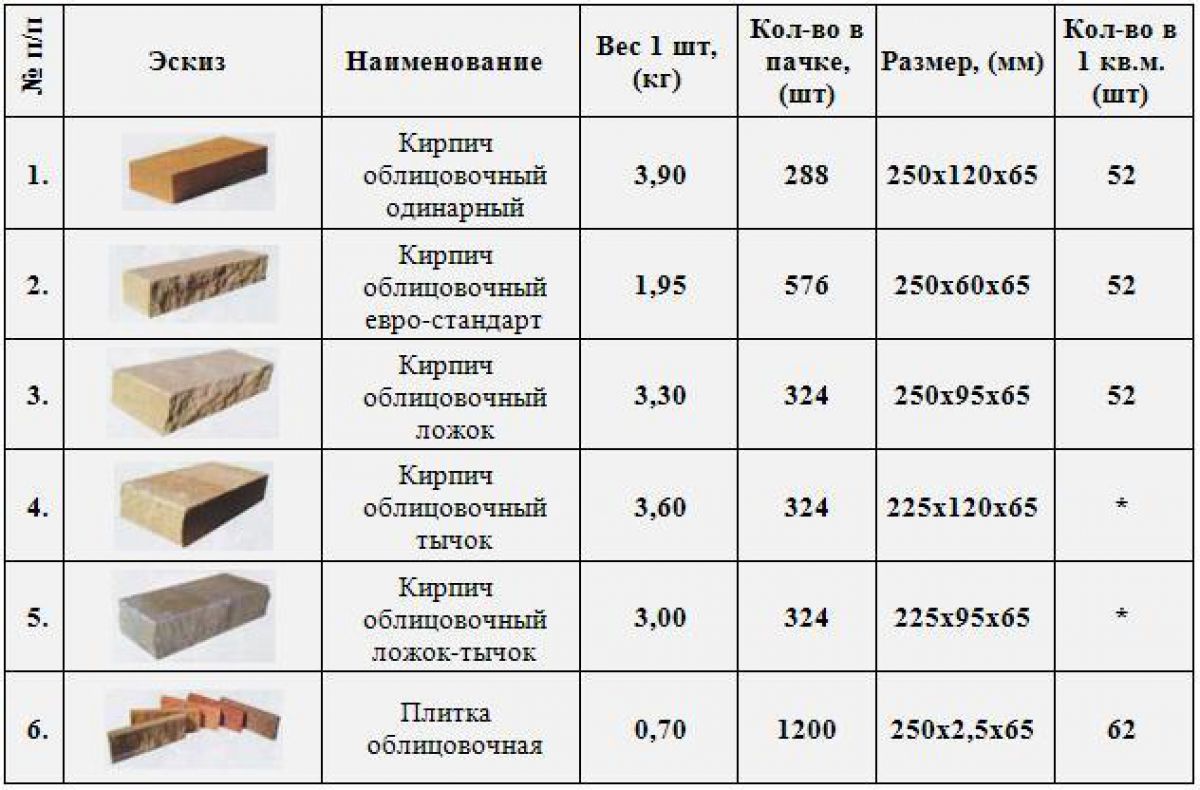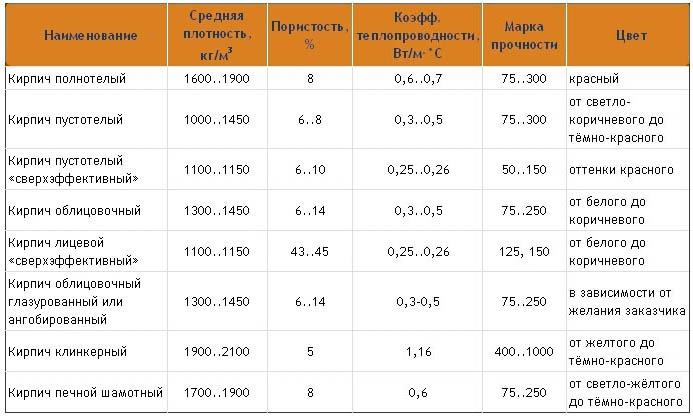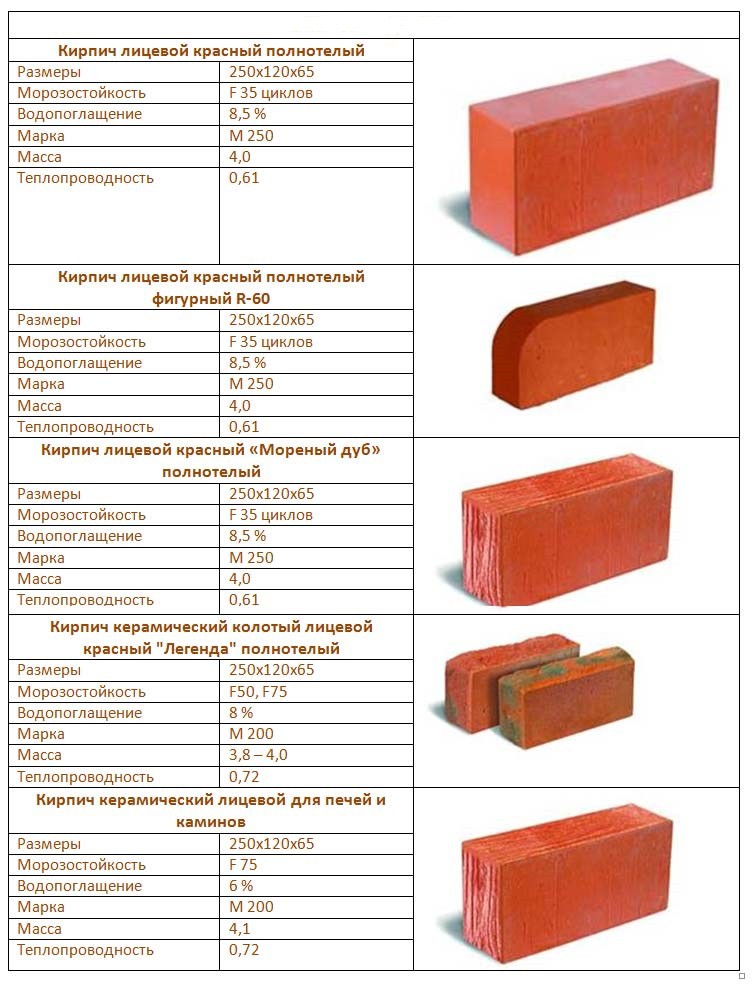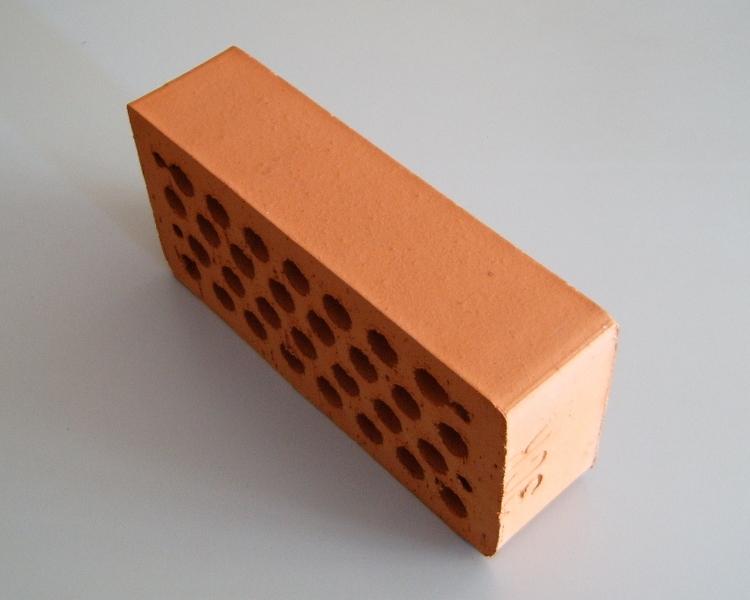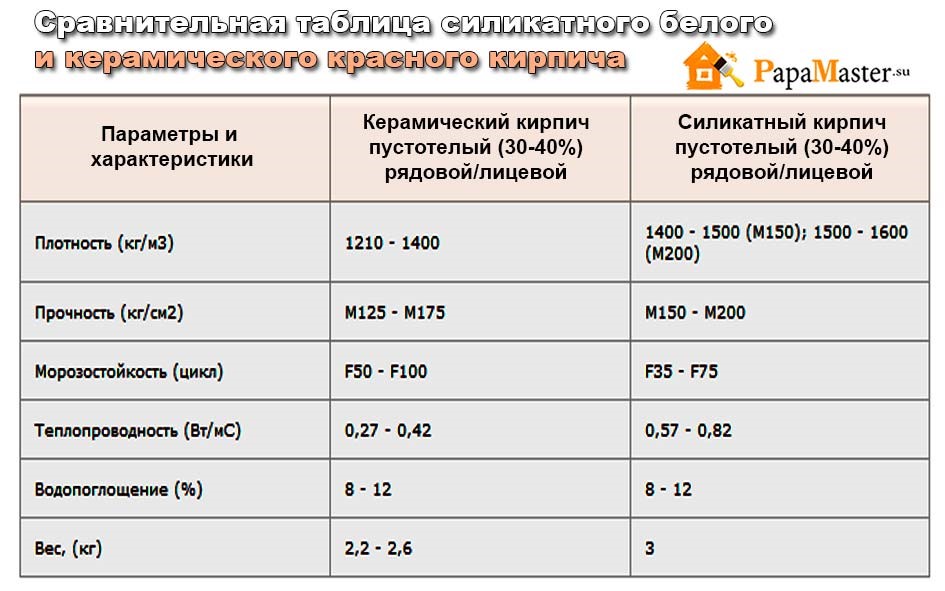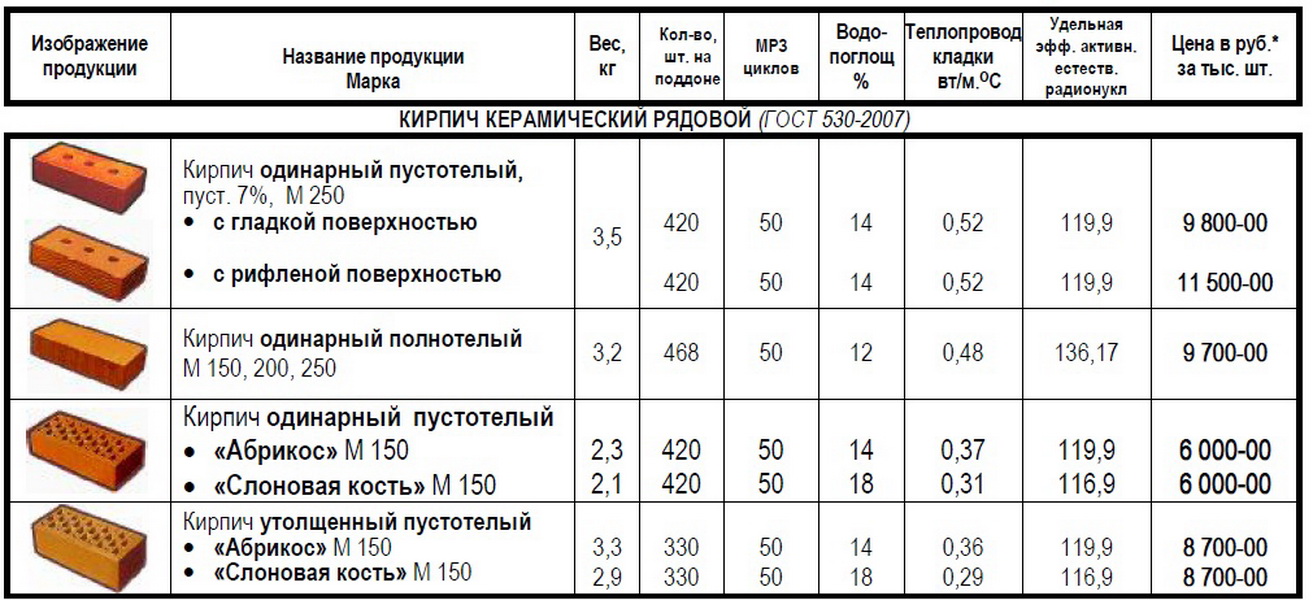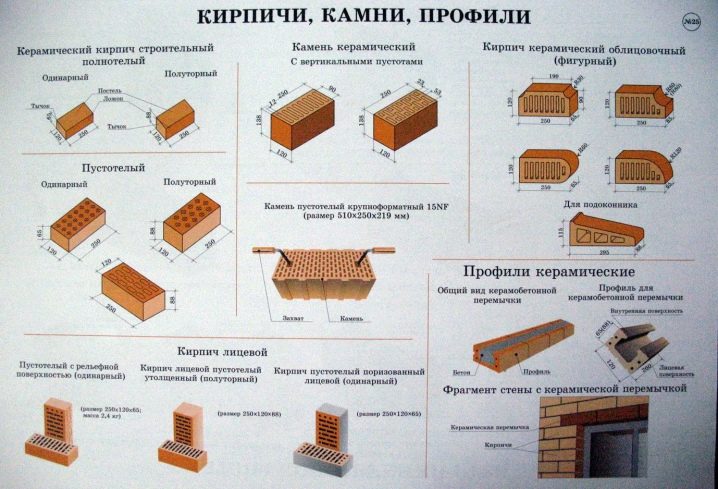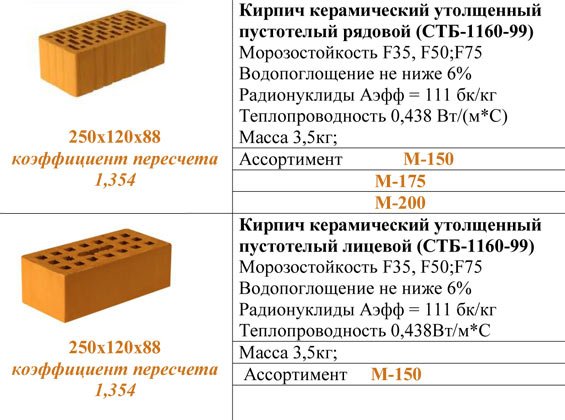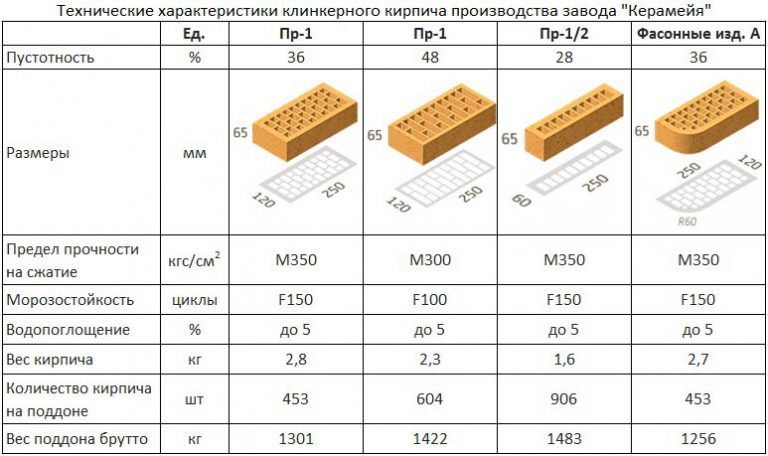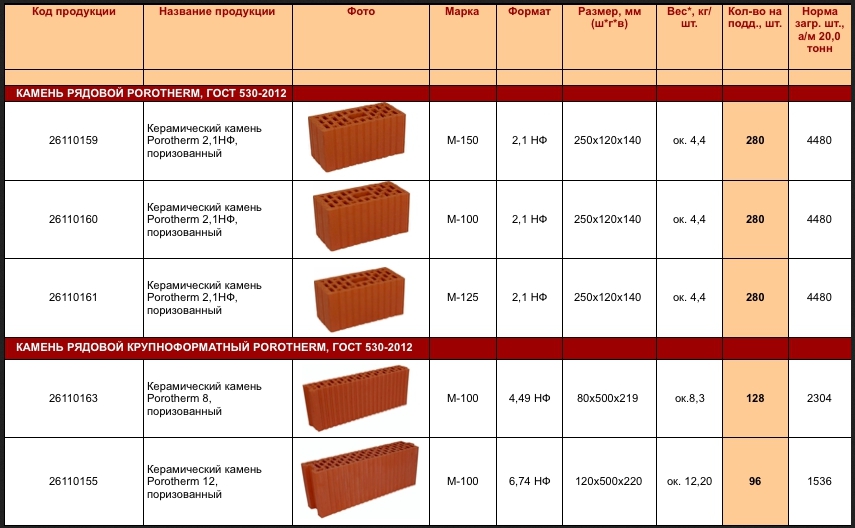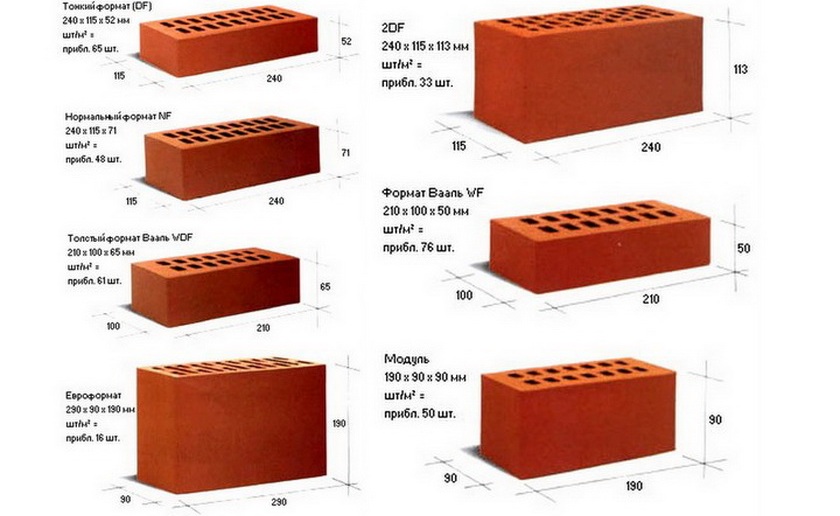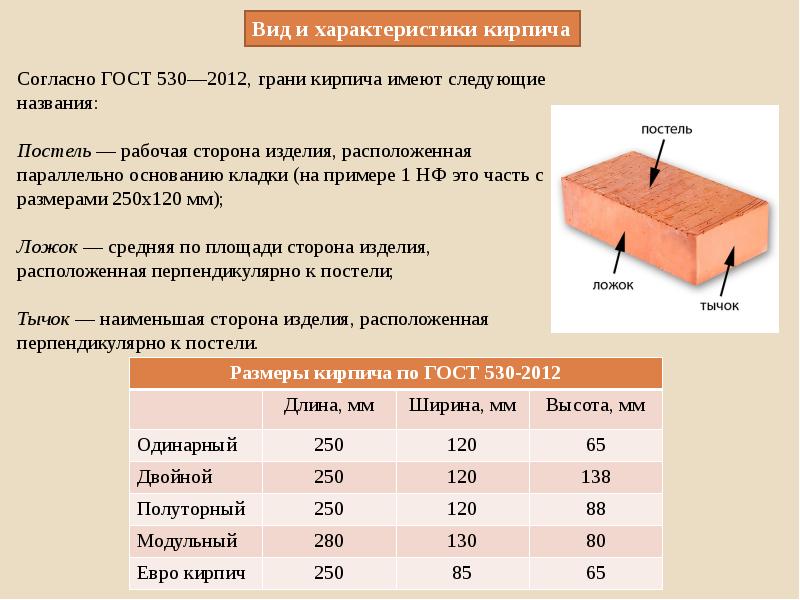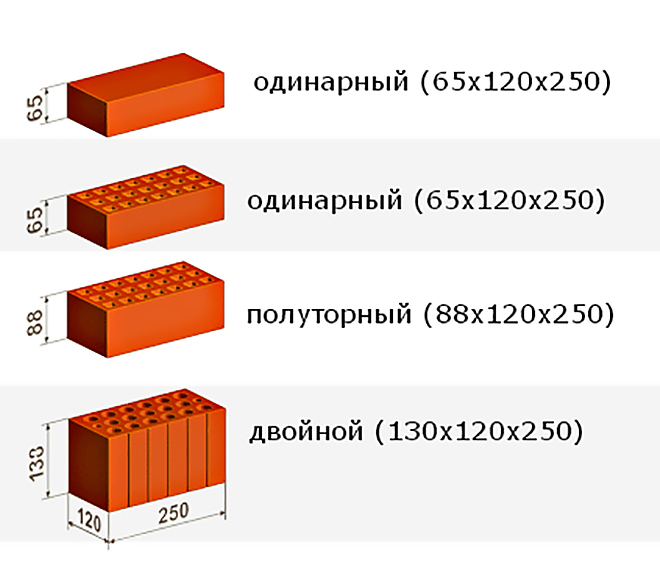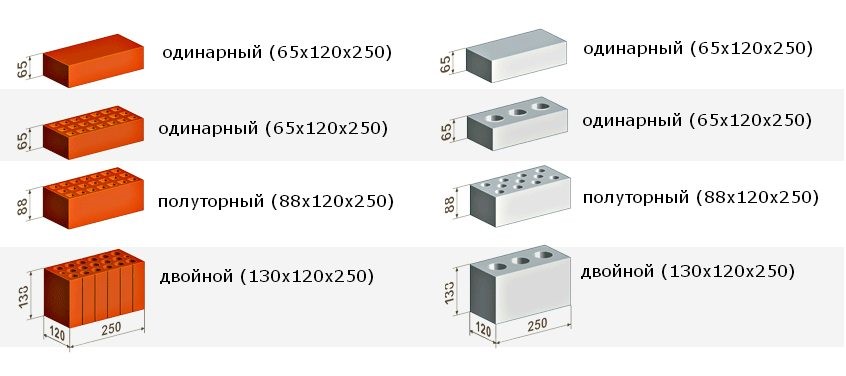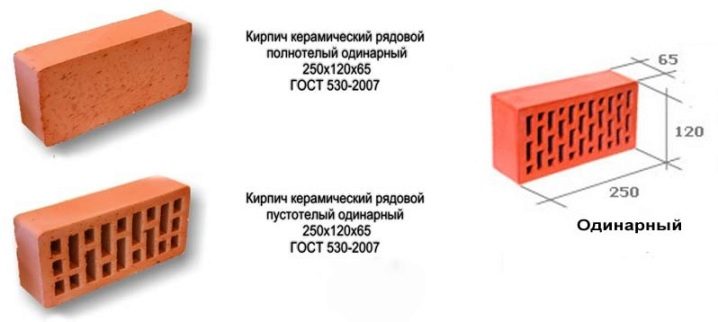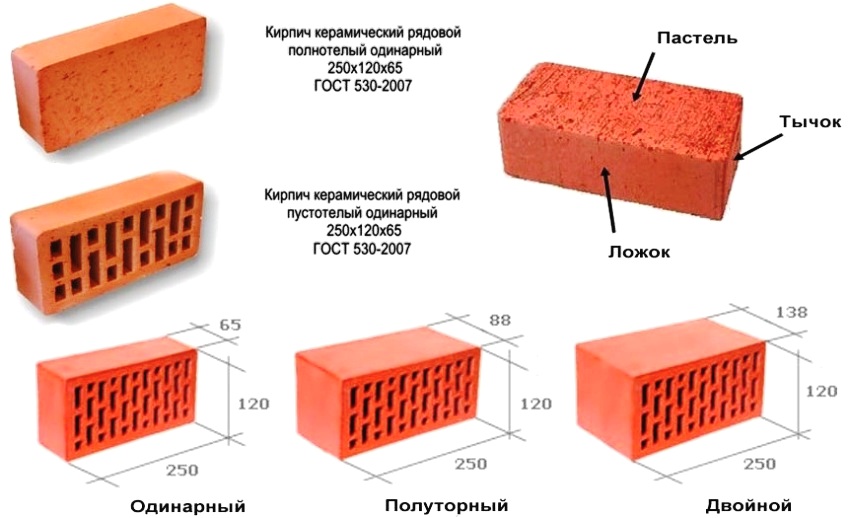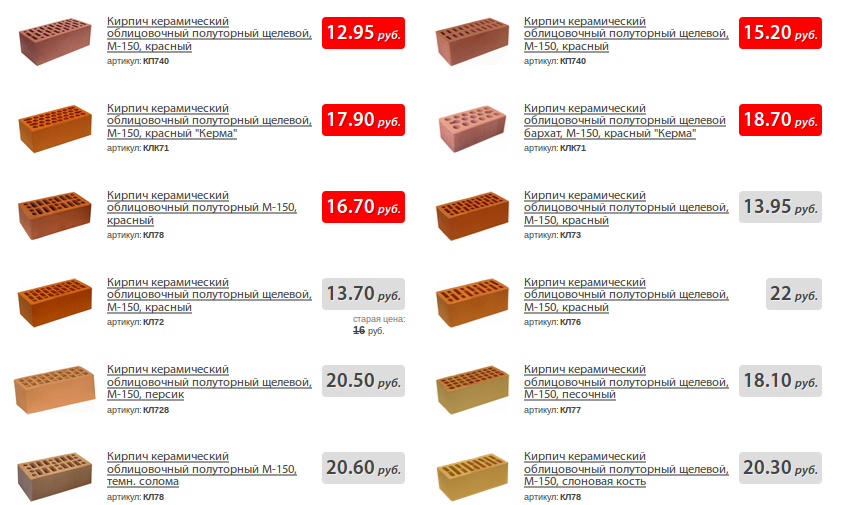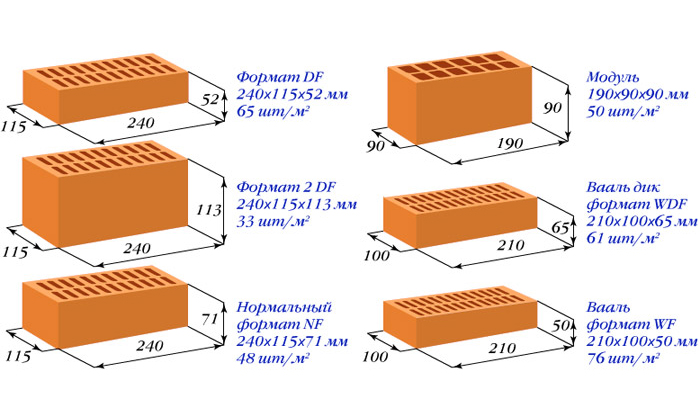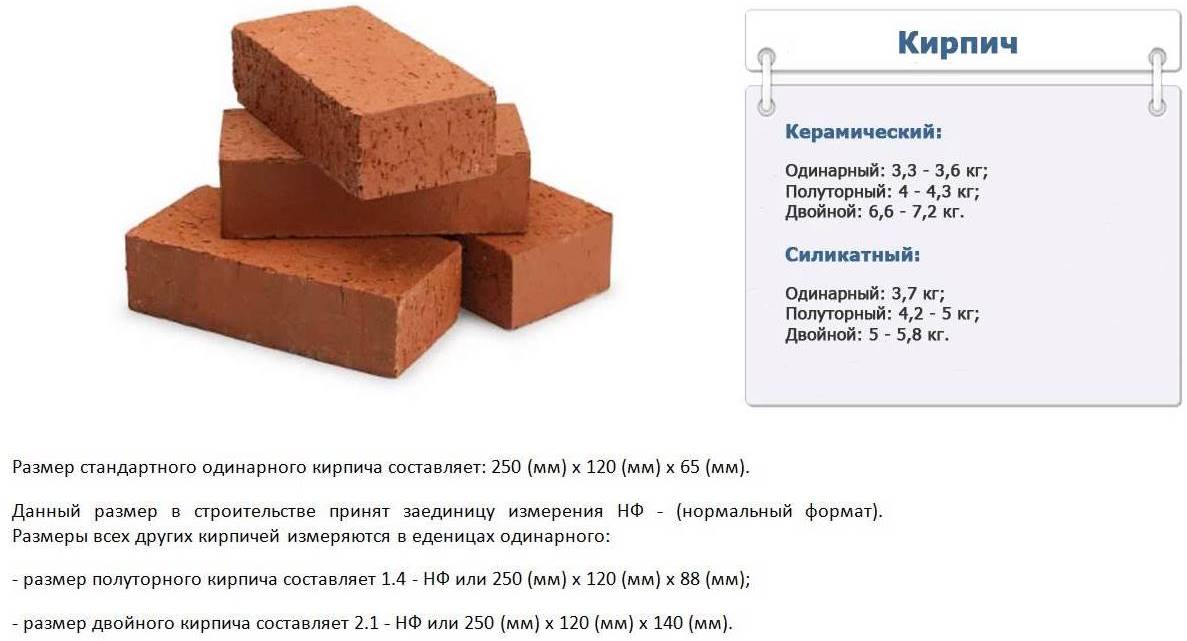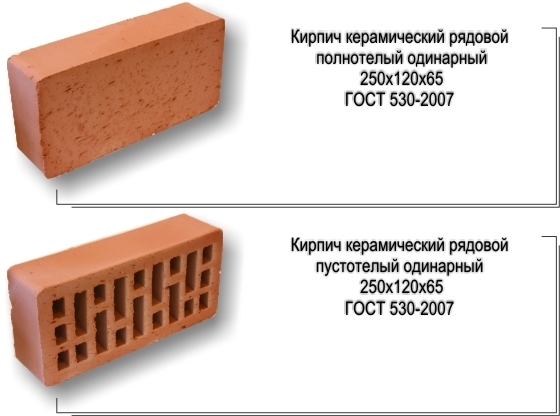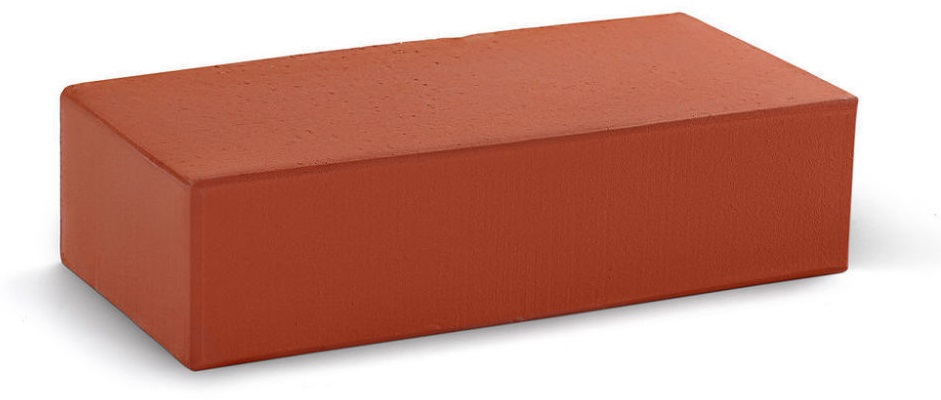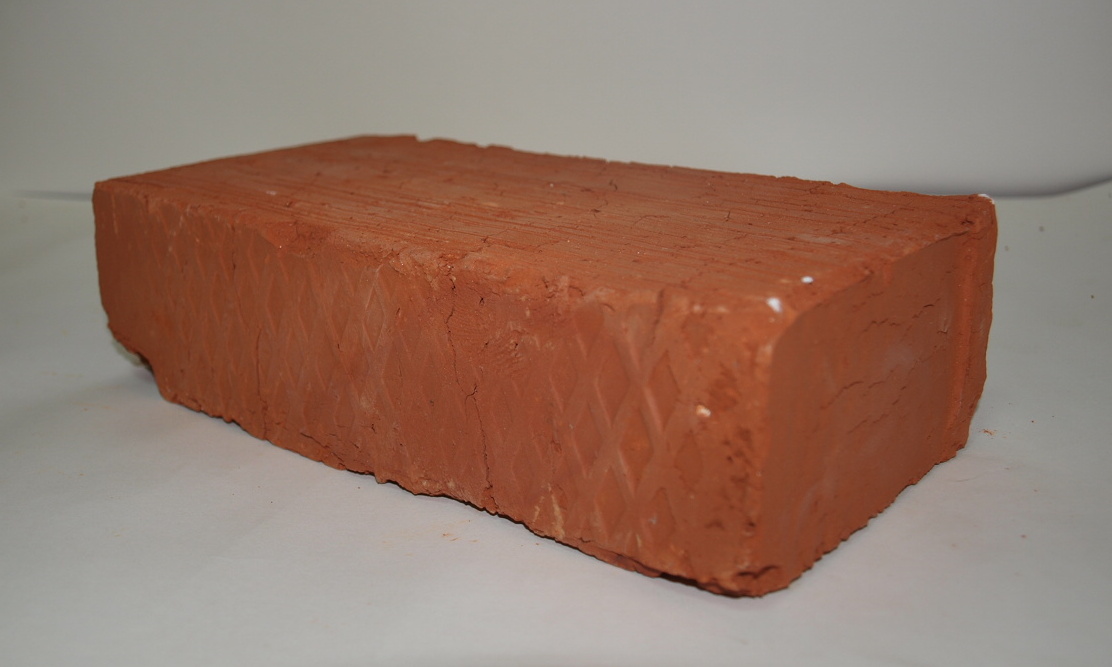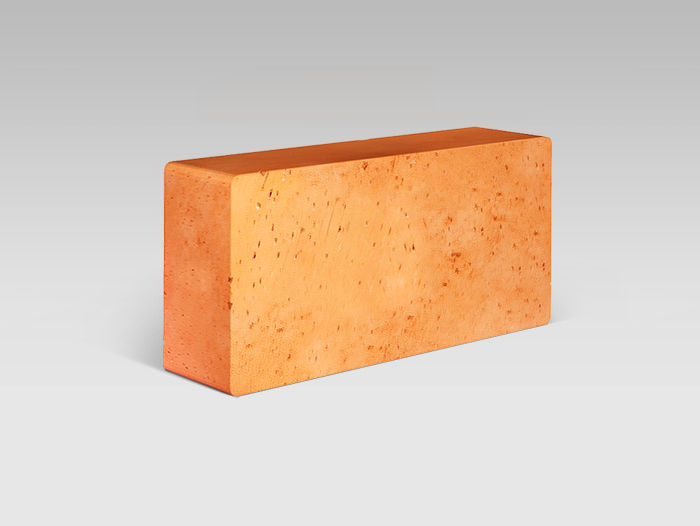Specifications
Red solid brick is a type of ceramic brick and has high performance properties. The material is used in the construction of objects, the walls of which will be subjected to regular or periodic weight, shock and mechanical loads. Solid products are often used to erect columns, arched structures, and pillars. The ability of the material to withstand heavy loads is due to the high strength of the clay composition from which it is made.
Each of the types of solid bricks is assigned a certain strength index, which greatly facilitates the selection of the required material. The index consists of two characters, the first of which is denoted by the letter M, and the second has a numerical expression and shows the degree of strength of the material.
The strength of a material is greatly influenced by its density, which indicates how much mass of a substance is contained in one cubic meter. Density is inversely proportional to porosity and is considered the main characteristic of a material's thermal conductivity. The average density of solid red brick is 1600-1900 kg / m3, while its porosity varies in values of 6-8%.
Porosity is also an important performance indicator and affects thermal conductivity and frost resistance. It is measured as a percentage and characterizes the level of filling of the brick body with pores. The number of pores depends entirely on the purpose of the material and the technology of its manufacture. So, to increase porosity, straw, peat or crushed sawdust are added to clay, in a word, all those materials that, when burned in a furnace, leave small cavities filled with air in their place.
As for the thermal conductivity, its values for full-bodied models are quite high. This imposes certain restrictions on the construction of residential buildings from solid material and requires additional measures to be taken to insulate the facades. So, the thermal conductivity index of solid products is only 0.7, which is explained by the low porosity of the material and the absence of an air gap inside the brick.
Solid ceramics are widely used in the arrangement of structures, which are subject to increased fire safety requirements. This is due to the high fire resistance of the material and the ability of some of its modifications to withstand temperatures up to 1600 degrees. In this case, we are talking about fireclay models, for the manufacture of which a special refractory clay is used with a higher firing temperature during production.
An equally important indicator is the frost resistance of the material, which is also indicated in the marking and denoted by the symbol F (n), where n is the number of freeze-thaw cycles that the product can withstand. Solid brick has an F75 index, which allows it to last up to 75 years, while maintaining its basic performance characteristics and not undergoing deformation. Due to its long service life, the material is often used for the construction of fences, open gazebos and outdoor stairs.
Water absorption also has a large effect on the performance of a material and refers to its ability to absorb and retain moisture. The hygroscopicity of a brick is determined empirically in the process of selective test tests, in which a dry brick is first weighed and then placed in water for 38 hours. Then the product is taken out of the container and weighed again.
How is it made?
Today, solid bricks are produced using a special technology in several stages.
Before the immediate start of brick making, suitable raw materials are selected. The selected mass is properly prepared for further use.
Previously, raw materials such as clay will need to be slightly moistened using steam. It is necessary to achieve the most plastic consistency so that it can be formed. Also, all hard and stony inclusions are removed from the composition.

Then a raw brick is formed. This process is automatic in most circumstances. The strip with the raw material is cut using a special device into a variety of blanks. Their dimensions, as a rule, are slightly larger than those of finished products, since after going through all the production steps, the clay shrinks noticeably.

The next step is drying the prepared semi-finished product.
It is extremely important here to follow the appropriate technology for the drying process. It is necessary to gradually and slowly solve the specified problem.
It is important to keep in mind that excessive acceleration of this process often provokes cracking of bricks, and it is better not to use such a material in construction work - it will be unreliable.
This is followed by firing the workpiece. It is carried out in a specialized oven. The temperature regime of heating in such conditions usually reaches 950-1000 degrees
At this stage of manufacturing, it is very important to comply with all the requirements that are laid down in the technological process.
The semi-dry pressing method involves the following steps:
- first, the clay, as in the previous version, is moistened to the required level, after which the raw material is processed into powder;
- the resulting mixture is poured into special molds in order to later get raw bricks;
- A similar semi-finished product is sent straight to the kiln for firing almost immediately after the forming stage.

Solid silicate brick is made according to the technology described below.
- Raw materials prepared from sand, ground lime and water are mixed to a homogeneous mixture.
- The resulting mixture is kept until the lime in it is completely extinguished.
- In the next step, the composition is pressed into bricks under high pressure. After that, the resulting semi-finished product is sent to specialized equipment. This process usually takes about 8-14 hours.
- Over the next 10-15 days, the building materials are kept for proper carbonation.

As for the popular fireclay bricks, it is produced by firing crushed refractory clay that has been pre-fired. In this case, crushed defective ceramic products can act as raw materials.

Silicate and ceramic bricks

Silicate brick M 200
Silicate brick M 200 is a white building material, which includes quartz sand, lime and water. This raw material is treated with high-temperature steam under pressure until the material is solid.
Ceramic brick M 200 is made of clay with the addition of various kinds of impurities and its subsequent firing in autoclaves at 1000-degree temperature. It differs from silicate brick in its characteristic reddish color. Although its final shade depends on the minerals that are included in the clay, the elements added to it and the firing temperature.
In ordinary building (ordinary) brick, they usually do not pay much attention to the final color, since this material does not serve for interior masonry. Also, the surface of an ordinary brick can and should be rough and have slight fractures along its borders. This ensures better absorption of the mortar and therefore the strength of the supporting structure. But the existing cracks on the surface should not reduce the strength of the material and allow it to be broken manually. If a brick falls apart in his hands, this indicates his marriage.
Facing brick M 200, on the other hand, serves to give a decent look to the house, therefore special requirements are imposed on its surface. It should be not only strong, smooth, but also a certain color, which is achieved with the help of various additives to the clay. The cost of such a building material is always higher than that of an ordinary one.
Both silicate and ceramic bricks can boast of high strength and frost resistance, good sound insulation, and reliability. But silicate brick is characterized by high water permeability, therefore, when building foundations and plinths, it is preferable to use a ceramic material. At the same time, it is better and much more convenient to use silicate material for the construction of walls of load-bearing purposes and partitions. In addition, the price of silicate brick M 200 is usually lower than that of ceramic.
Types of ceramic bricks M-150

Ceramic brick M 150
All products of this brand are available in two types:
- working (corpulent or ordinary) brick;
- facing (hollow) brick;
This separation is caused by the structure of the building bricks. Full-bodied products do not contain voids inside themselves and have a rough appearance. Its main purpose is the erection of plinths, foundation structures, load-bearing walls and other structures that require subsequent finishing. It is used to lay out ventilation and smoke ducts.
The building brick of the M 150 brand owes its popularity to significant advantages, which favorably distinguish it in the line of other building materials. So, the weight of the brick M 150, depending on the modification, ranges from 2.2 to 3.5 kg. Such a small mass implies convenience for transportation across floors during construction work.
Of the main qualities of solid bricks, one can single out excellent strength and a high rate of thermal conductivity, which allows you to keep heat in the premises in winter, and in summer to provide the house with coolness. M-150 products also have high sound insulation, therefore, its use is advisable in cases where it is necessary to minimize the noise level from the outside.
Working single solid brick M 150 is also used for the construction of load-bearing walls of houses and other structures. Its difference from the hollow analogue is that it has voids in its structure, which significantly reduce the weight of ceramic blocks. Hollow ceramics are also highly frost-resistant due to the presence of empty spaces filled with air, which is a poor conductor of heat. The price of solid brick M 150 varies from 8 to 15 rubles. per piece, depending on the modification and manufacturer.
Modern production technologies make it possible to produce facing bricks M 150 with a beautiful and impeccable appearance. Such characteristics determine its use in facing the facades of buildings, columns, decorative fences.
Whatever brand or modification the building stone is, clay is the raw material for its production. The quality and composition of raw materials depends on the region of its production, but in any case, these raw materials should be homogeneous in structure and with the lowest limestone content. During firing, an excess amount of limestone contributes to shooting and spalling from the surface of the finished stone.
Ceramic solid brick M 150 can be produced in two ways:
- plastic molding;
- dry and semi-dry pressing.
The first manufacturing method is by far the most popular and cost effective. The peculiarity of the production is the use of clay, which contains up to 30% sand, which prevents excessive shrinkage of the finished products. The prepared mass of clay is moistened with steam and intensively mixed into a homogeneous mass with a complete absence of lumps.
At the next stage, a raw bar is formed with a volume that exceeds the finished product by 10-15%.After drying, during which the humidity decreases, the products are fired in an oven at temperatures up to 1000 ºС. Ordinary hollow brick M 150, made in this way, has high strength, water resistance and fully complies with GOST.
In the second method, the finished product, although it has less frost resistance, has a more regular and clear shape. At the same time, raw materials are selected with certain moisture indicators (from 7 to 12%). During the production process, the clay is ground to a powder. The finished powder is subjected to dry or semi-dry pressing, after which the raw stone is fired in an oven.
The manufactured products must have a quality certificate and comply with the approved certificates.
Modern production workshops allow the production of working bricks and facing bricks M 150 of various configurations and sizes:
- single;
- one and a half;
- double.
The variety of color shades allows the use of building stone in the widest spectrum of construction. The most common colors are red, brown, light yellow, straw, as well as more refined ones - ivory, frost, terracotta.
The dimensions of the M 150 brick supplied to the market may vary depending on the modification. The most popular today is a single brick 250 * 120 * 65 mm, used for the construction of capital walls of buildings and foundations.
Types and characteristics of ceramic bricks
The variety of brick products allows them to be divided, classified.
Brick types
An artificially produced stone, with given shapes, sizes, mass and composition, can be divided into bricks:
In common parlance, it is often divided into red (ceramic) and white (silicate). The difference is in the main raw materials in their manufacture. For red it is clay, for white it is a silicate mixture (sand and lime).
Ceramic products, in turn, according to their purpose and application, are divided into the following type:
- Private. It is used in the masonry of load-bearing, enclosing walls and partitions.
- Facial. Used for cladding.
- Special. It is used in the laying of stoves, fireplaces, chimneys (stove, refractory fireclay bricks).
Sizes, their designations
According to the above regulatory construction documentation, all types of this building material in Russia are standardized in their standard sizes.
Size designation
Since 1927, brick products have been standardized. There is a normal format (NF), its geometric dimensions are 250x120x65 (mm).
The name of other standard sizes comes from the normal format:
- 250x120x65 - single (NF);
- 250x120x88 - one and a half (1.4 NF);
- 250x120x140 - double (2.1 NF).
In the current documents, they are divided, classified according to other sizes:
- 250x85x65 - "euro" (0.7 NF);
- 288x138x65 - modular single (1.3 NF).
By the absence or presence of voids in the body, they separate solid and hollow brick products. By voidness, the following varieties are distinguished:
The mass of the product, the weight of the masonry, the cost of its construction, and most importantly, the heat-shielding characteristics of the wall, depend on the number of voids (the percentage of voids from the total volume).
Layout: Two-layer wall (full-bodied front and hollow "warm ceramics")
Weight characteristics
Photo: the weight of a single ceramic brick depends on the volume of voids in it
Designers should take into account the mass to calculate the load of the masonry on the foundation, to determine the carrying capacity of transport, warehouse equipment (loader, crane) during logistics operations with it.
It is useful for an estimator, foreman or bricklayer who works with him with his own hands to know that, for example, 1 m3 of single solid brick masonry (about 500 pieces) is approximately 1690 - 1847 (kg). A cube of one-and-a-half brick is about 380 pieces, and of a double brick - about 200 - 240 pieces.
Attention! When calculating, you can focus on the following figures: about 7 rows of double, 10 rows of one and a half and 13 rows of single bricks fit in a 1 meter high masonry. Here are the main weights for standard sizes (in accordance with the current documents on building materials)
Here are the main weights for standard sizes (in accordance with the current documents on building materials).
Designation according to GOST
Hollow double silicate brick m 150, dimensions 250x120x138, weighs 5.4 - 5.8 (kg), and hollow double ceramic brick m 150, 250x120x140, weighs 4.3 - 5.0 (kg).
The mass of a full-bodied 250x120x65 is 3.3 - 3.6 (kg), and of the same porous volume - 2.4 kg.
Thus, we see that a large volume (size) does not necessarily mean that its mass will be large. Its weight characteristics are more influenced by the structure.
When choosing the type of building material for walls, one must take into account their thermophysical characteristics, structure, weight and geometric parameters, what is the price of their purchase, delivery and their further operation.
When laying a large array of walls, it is advisable to pay attention to one-and-a-half and double bricks, to large-format blocks of "warm ceramics". To simplify approximate calculations, you can focus on the average weight indicators.
Solid with less than 13% void - about 4 kg, hollow with more than 15% void - about 2.5 kg
To simplify approximate calculations, you can focus on average weights. Solid with a voidness of less than 13% - about 4 kg, hollow with a voidness of more than 15% - about 2.5 kg.
Features of production
Red brick can be called a strategic material, therefore the production process is strictly regulated by national standards. Today they are guided by GOST 7484-78 and GOST 530-95. According to regulatory documents, clay with a minimum content of marl and sulfates is used as raw material. Open pit mining is carried out, and brick factories are mainly located near deposits. As a rule, clay has a reddish tint, so the finished material is called red brick, although its official name is ceramic brick. During the production process, colored pigments may be added to the mass, and then the finished brick will not have the usual terracotta color. The shade of the product strongly depends on the characteristics of the raw material, therefore, bricks of different colors are obtained from the clay obtained in different deposits.
The clay mass is formed on belt presses, and the uniformity of the composition and the absence of voids is achieved through the use of vibration stands. This is followed by drying and firing. Raw bricks are dried using a chamber or tunnel method. The first option involves drying the workpieces in a room where the temperature and humidity parameters change in the required sequence. Tunnel drying method involves the passage of trolleys with raw material through zones with different microclimate. The result is almost the same.
The mass is fired in furnaces at temperatures of 950-1050C until a part of the glassy phase in the product reaches 8-10%. It is with these parameters that the brick acquires the best strength indicators. Correctly fired brick gives a ringing sound on impact and has a reddish-brown tint. If you do not burn it, then the color will be closer to mustard, and the sound upon impact will be muffled. Burnt brick can be recognized by its melted edges and dark core.
The properties of the finished brick also depend on which method of formation was chosen:
- the plastic method of formation involves the manufacture of bricks from a clay mass with a moisture content of 15-30%. The product is obtained by extrusion. For the production of hollow samples, vacuum installations are used. Blanks are dried in a chamber and fired in ovens or tunnels.Such a brick is more frost-resistant and is recommended for building a house;
- dry and semi-dry method of formation. In this case, a clay mass with a lower moisture index (about 7-12%, it all depends on the characteristics of a particular production) is used, a raw brick is made from it by pressing under pressure up to 15 MPa. Drying is absent altogether or is present in an abbreviated version. The final stage is firing. In terms of performance, such a brick is slightly inferior to a plastic molded brick, but it has a more accurate geometry. In this way, facing ceramic bricks are usually produced.
Ceramic bricks are used for laying foundations, in private construction for the construction of load-bearing walls and partitions, outbuildings and garages. The facing type of brick has found wide application in the decoration of facades, and is also sometimes used for interior decoration.
Pros and cons of ceramic bricks
The advantages of ceramics include naturalness, harmlessness. If we compare ceramics and silicate, then clay products win a little in terms of thermal conductivity. If you look at the indicators, then the difference is very small. But a ceramic house is much warmer than a silicate one. The point is in the higher heat capacity. Clay can store more heat and is therefore warmer at home.
Ceramics are inferior to silicate in sound insulation properties, as well as in geometry and stability of characteristics. This is its main disadvantage. Moreover, at a high price, often efflorescence, with which it is very, very difficult to fight. Another drawback is that even the front surface is rarely even.
Ceramic brick is a traditional material for building houses, which is more than one hundred years old.
All these shortcomings are understandable. Ceramic bricks are obtained by firing pre-shaped parallelepipeds from clay mortar. Clay is a natural material that has various properties. The different properties of different types of clay are the main reason that the size of ceramic bricks does not differ in stability. Moreover, a significant spread can be within the same batch. And from party to party, in general, there may be significant differences. The different characteristics of the feedstock also cause a wide variation in the characteristics of the finished product. Such as strength and density.
Service life - reality is not happy
In many respects, ceramics should be better than the same silicate, but the reality turns out to be different. Recently, too often there is a red ceramic brick crumbling, dilapidated after several years of operation under normal conditions. The reasons are the complexity of the technology. For a good result, careful processing and preparation of the clay is required in order to exclude lime inclusions, which are the reasons for "shooting". And this is additional time in an already not short production cycle. And extra energy. And expensive equipment, which is not bought by everyone.
Not the best picture
The second point: holding the temperature regime of firing. Burnt ceramic bricks behave normally in masonry. It only looks worse, as it is darker than the "norm". It's not so scary. But the unburned one collapses, crumbles. And this is why he is dangerous. Ceramics are fired in the furnace for a long time, and so it takes a little to reduce the time in order to increase productivity. Hence the underburning. Or fuel economy, which is far from cheap. So compliance with the technology for the production of ceramic bricks is a high price for products. And expensive bricks are bought very reluctantly. So the collapsed red brick most likely had a low price. And everyone knows that cheap is very rare. Nevertheless, the budget for a construction site is usually not a rubber one and you have to save money.
In terms of thermal conductivity and some other parameters, ceramic bricks should be better
No matter how complex the production technology is, European supplies have a geometry close to ideal, and the dimensions are standard, and the quality is stable. Their price is far from budget, but quality problems are rare. So if the funds allow, they try to buy imported bricks. Domestic clay, even expensive, still cannot boast of stability of quality. That is why, although ceramics should be better in many respects, more and more often the choice is made in favor of silicate. Because for quite reasonable money you can buy good quality building material. He is chosen even though he is much colder. All the same, in order to achieve the required level of energy efficiency, it is necessary to insulate the ceramics too.
No. 9. Brick size
After the color, type and nature of the filling has been determined, the next question arises - what size of brick is needed. According to GOST 530-2007, a standard brick has dimensions of 250 * 120 * 65 mm, and all standard sizes are determined relative to it:
- single brick - this is the same standard one, it is the most versatile, it is used both for masonry and for cladding, it is convenient to work with this, since it fully corresponds to a person's hands;
- one and a half size 250 * 120 * 88 mm is used when laying massive structures and allows you to significantly save time;
- double size 250 * 120 * 138 is rarely full-bodied, and hollow is used in lightweight masonry;
- narrow size 250 * 60 * 65 is used only for decorative purposes;
- a thin one measuring 250 * 22 * 65 mm is already, in fact, a tile, the scope of which is facing work;
- there are also bricks "euro" (0.7 from the standard thickness), modular (1.3 from the standard thickness), incomplete brick and other exotic standard sizes, which are rarely used in construction.
Historically, the edges of the brick are called the bed (the working largest part of the product), the spoon part (the long side edge) and the poke (the smallest edge). Some manufacturers and stores use exactly these concepts, so it will not be superfluous to remember them.
Knowing which structure (or decoration) is to be completed, given its size and dimensions of the most suitable type of brick, you can easily calculate how much material is required, but it is still better to take it with a margin.
Product Specifications
The technology for making bricks M 125 can be different: semi-dry pressing or plastic molding. But in any case, according to GOST, the product is fired in a furnace at high temperature. There are various product modifications. Distinguish:
- private;
- facing;
- corpulent;
- hollow.
The choice depends on the purpose of the material.
Facing brick М 125

Hollow brick M 125 has a textured surface, and is usually used as a facing material for external and internal walls of buildings of various storeys. They are used to decorate surfaces to which high aesthetic requirements are imposed.
Technical characteristics of facing bricks:
- size - 250x120x65 mm;
- weight - from 2.2 kg to 2.5 kg;
- bending and compressive strength - 1.4-1.6 MPa;
- water absorption - up to 8%;
- thermal conductivity - from 0.2 to 0.26 W / m.degree. C.
The uniform color of the product indicates its high quality. Experts recommend buying bricks for finishing from one batch. Facing brick has ideal proportions, so it looks very neat and aesthetically pleasing when laid.
Solid brick М125
 Solid brick M 125 has a relatively small volume of voids, the value of which does not always reach 13%, therefore it is used for the construction of residential buildings, industrial and administrative buildings, columns, garages, outbuildings and outbuildings, storage facilities. The advantage is the ability to operate the material in various climatic conditions.The product has a rough rough surface, therefore, when constructing buildings, it is recommended to additionally plaster the walls.
Solid brick M 125 has a relatively small volume of voids, the value of which does not always reach 13%, therefore it is used for the construction of residential buildings, industrial and administrative buildings, columns, garages, outbuildings and outbuildings, storage facilities. The advantage is the ability to operate the material in various climatic conditions.The product has a rough rough surface, therefore, when constructing buildings, it is recommended to additionally plaster the walls.
The use of the product for the construction of load-bearing structures of buildings gave it the following names: ordinary, building, ordinary brick M 125.
Technical characteristics of brick M 125 solid, correspond to GOST 530-2007, and have the following meanings:
- dimensions of brick M 125 - 250x120x65 mm;
- bending and compressive strength - 1.4-1.6 MPa;
- brick weight M 125 - 3.4-3.5 kg;
- water absorption - from 6% to 8%;
- frost resistance - from F50 to F75;
- thermal conductivity - 0.513 W / m.degree. C.
The porosity of a brick affects its thermal conductivity, water absorption and the quality of the resulting adhesion to the mortar. Judging by the above characteristics, brick M 125 has low thermal insulation properties, so the walls built from this material must be additionally insulated.
How to choose?
When choosing a high quality solid brick, you need to focus on some important parameters.
It is imperative to request a quality certificate for the selected product. This document should indicate that solid brick fully complies with GOST. The brand of building material is also mentioned there. If the certificate was refused, then it is better to go to another store for bricks, otherwise you can buy low-quality products.
Experts do not recommend buying bricks with a grade lower than M75.
You need to carefully examine the bricks you pick up. They should be free of cracks, chips, scratches, stains (any - both light and dark), or other defects. It is worth remembering - you cannot buy such building materials with flaws, since they will not last long.
Experts recommend, when choosing a brick, gently knock on its surface with a hammer or any iron part, and then pay attention to the sound being emitted. It should be voiced, not deaf
You should not save on the purchase of this building material. Items with suspiciously tempting prices may be of low quality. Such goods are unlikely to make good structures.
You need to apply for the purchase of solid bricks at proven retail outlets that have a good reputation in the city of residence. It is better not to buy such things in questionable stores and shops - in terms of quality, they may turn out to be completely different from what the seller claims.
General information about the strength of bricks
The strength of a brick is indicated by the letter "M" and a number indicating what kind of load per square meter. cm is able to withstand the product. The brick is marked in strict accordance with GOST. For this, several bricks are taken from each batch of finished products, which are subsequently tested for compression and bending. In the course of research, the grade of stone is established from M 75 to M 300. The established marking corresponds to all types of material, for example: solid face brick M 150, has the same strength as hollow brick. But each brand of product has a different purpose, due to the technical characteristics and properties.
Among all the variety of materials, the most common building brick of the M 125 brand, which, due to its reliability, strength, is used for the construction of the upper floors of multi-storey buildings, internal and load-bearing walls, pillars and columns, partitions and others. The price of brick M 125 is quite affordable and depends on the type of product. But in order to make the right choice, it is necessary to study the properties and characteristics of the product more carefully.

